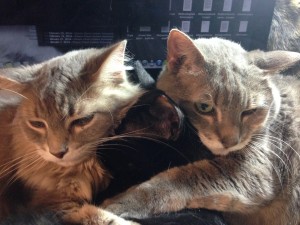
Thanks for the question, Russ. Here’s a picture of two cats hugging a kitten. Or maybe they’re trying to smother him. I don’t know.
I really like your articles and recipes on partial mashing, but my question is which is better, a full-wort boil using extract with steeped grains methods or using partial mash methods without boiling the full wort?
— Russell Albright (Keizer, Oregon)
Most homebrewers begin brewing by following recipes that call for steeped specialty grains that add color and flavor to their beer, and light malt extract for the bulk of the fermentable sugars. The hops are boiled in this wort, which is generally smaller in volume than the full batch size. This “thick” wort is then diluted to working strength in the fermenter.
With fresh ingredients, sanitary equipment and a healthy pitch of yeast, you can make very good beer this way. However, after brewing awhile using this method, many brewers become aware of its limitations and wish to upgrade their techniques to be able to brew a wider range of beers. Specifically, stovetop wort boils tend to have a minimum color level above the level that some brewers would like to make. Brewing the lightest-colored beers is a challenge. Likewise, brewing very hoppy beers is more of a challenge because hop utilization is poorer in “thicker” worts — and adding more hops results in more thick wort lost to the “gunk” at the bottom of the brewpot. And finally, extract beers are often lacking in malt aroma, especially the aroma of base malts — the most lightly kilned malts that must be mashed.
So which is better, upgrading to a full-wort boil or switching to partial mash methods? Before addressing that question, I’d just like to point out that these are not mutually exclusive — if possible, do both. However, that wasn’t the question that was asked.
In most cases, I would prefer the stovetop partial mash beer because the added base grains will give the beer some added malt aroma. You can easily make a few gallons of wort from the partial mash, boil the hops in it, then stir in malt extract around knockout to reach your target OG in the fermenter.
However, if you’re stuck boiling extremely thick wort on your stovetop — less than 2.5 gallons (9.5 L) per 5-gallon (19-L) batch — then I’d probably go with the full boil option.
Answering this question is a bit like picking between apples and oranges. Each change has a different effect on your beer. So, for the individual brewer, the devil is in the details. Which will improve your beer more? It depends on your starting point. In most reasonable cases, though, I’d go with the partial mash beer. If you can do this and manage to boil at least 2.5 gallons (9.5 L) of wort on your stovetop (for a 5-gallon/19-L batch), you’ll be able to successfully brew a wide range of beers without having to move your brewery out of your kitchen. And as I mentioned before, if possible, do both. One way to do this is to scale down. (See the “related articles” below this post for more information on improving malt extract based beers.)
Thanks for the question.
If you have a question you’d like answered, email me at chris@beerandwinejournal.com. I’ll try to send you a quick answer within a day or so, then flesh out the answer for this Q and A column as soon as possible.
—-
Related articles
Add Base Malts to Your Extract Beers
Five More Tips for Extract Brewers

Speak Your Mind